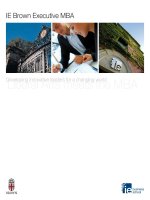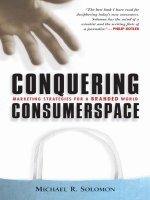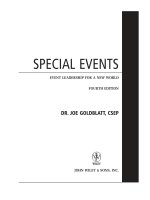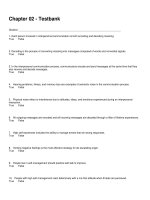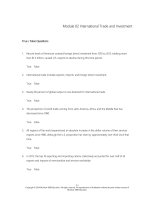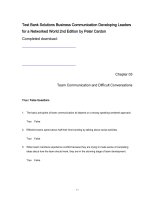Business communication developing leaders for a network world 2nd CHAPTER 7
Bạn đang xem bản rút gọn của tài liệu. Xem và tải ngay bản đầy đủ của tài liệu tại đây (1.72 MB, 30 trang )
Email and Other
Traditional Tools
for Business
Communication
Chapter 7
© 2016 by McGraw-Hill Education. This is proprietary material solely for authorized instructor use. Not authorized for sale or distribution in any
manner. This document may not be copied, scanned, duplicated, forwarded, distributed, or posted on a website, in whole or part.
Most Effective Communication Channels for
Coordinating Work
© 2016 by McGraw-Hill Education. This is proprietary material solely for authorized instructor use. Not authorized for sale or distribution in any
manner. This document may not be copied, scanned, duplicated, forwarded, distributed, or posted on a website, in whole or part.
7-2
Creating Effective Emails
Email communication is the primary form of
written business communication.
Most analysts expect it to be the primary tool
for at least the next five to ten years in most
companies
© 2016 by McGraw-Hill Education. This is proprietary material solely for authorized instructor use. Not authorized for sale or distribution in any
manner. This document may not be copied, scanned, duplicated, forwarded, distributed, or posted on a website, in whole or part.
7-3
Principles of Effective Emails
Use for the right purposes.
Ensure ease of reading.
Show respect for time.
Protect privacy and
confidentiality.
© 2016 by McGraw-Hill Education. This is proprietary material solely for authorized instructor use. Not authorized for sale or distribution in any
manner. This document may not be copied, scanned, duplicated, forwarded, distributed, or posted on a website, in whole or part.
7-4
Principles of Effective Emails
Respond promptly.
Maintain professionalism and
appropriate formality.
Manage emotion effectively.
Avoid distractions.
© 2016 by McGraw-Hill Education. This is proprietary material solely for authorized instructor use. Not authorized for sale or distribution in any
manner. This document may not be copied, scanned, duplicated, forwarded, distributed, or posted on a website, in whole or part.
7-5
Use Email for the Right Purposes
Email communication has few constraints (low
cost, little coordination) and high control (the
writer can think them out carefully, and they
provide a permanent record)
It is rarely appropriate for sensitive or
emotional communication tasks. It is also
inefficient for facilitating discussions
© 2016 by McGraw-Hill Education. This is proprietary material solely for authorized instructor use. Not authorized for sale or distribution in any
manner. This document may not be copied, scanned, duplicated, forwarded, distributed, or posted on a website, in whole or part.
7-6
Ensure Ease of Reading
1.
2.
3.
4.
5.
Provide a Short, Descriptive Subject Line
Keep Your Message Brief Yet Complete
Clearly Identify Expected Actions
Provide a Descriptive Signature Block
Use Attachments Wisely
© 2016 by McGraw-Hill Education. This is proprietary material solely for authorized instructor use. Not authorized for sale or distribution in any
manner. This document may not be copied, scanned, duplicated, forwarded, distributed, or posted on a website, in whole or part.
7-7
Less-Effective Email
© 2016 by McGraw-Hill Education. This is proprietary material solely for authorized instructor use. Not authorized for sale or distribution in any
manner. This document may not be copied, scanned, duplicated, forwarded, distributed, or posted on a website, in whole or part.
7-8
More-Effective Email
© 2016 by McGraw-Hill Education. This is proprietary material solely for authorized instructor use. Not authorized for sale or distribution in any
manner. This document may not be copied, scanned, duplicated, forwarded, distributed, or posted on a website, in whole or part.
7-9
Show Respect for Others’ Time
Select Message Recipients Carefully
Provide Timelines and Options
Be Careful about Using the Priority Flag
Let Others Know When You Will Take Longer
than Anticipated to Respond or Take Action
Avoid Contributing to Confusing and
Repetitive Email Chains
© 2016 by McGraw-Hill Education. This is proprietary material solely for authorized instructor use. Not authorized for sale or distribution in any
manner. This document may not be copied, scanned, duplicated, forwarded, distributed, or posted on a website, in whole or part.
7-10
Appropriate Response Time
to Emails
© 2016 by McGraw-Hill Education. This is proprietary material solely for authorized instructor use. Not authorized for sale or distribution in any
manner. This document may not be copied, scanned, duplicated, forwarded, distributed, or posted on a website, in whole or part.
7-11
Maintain Professionalism and Appropriate
Formality
Avoid Indications That You View Email as
Casual Communication
Apply the Same Standards of Spelling,
Punctuation, and Formatting You Would for
Other Written Documents
Use Greetings and Names
© 2016 by McGraw-Hill Education. This is proprietary material solely for authorized instructor use. Not authorized for sale or distribution in any
manner. This document may not be copied, scanned, duplicated, forwarded, distributed, or posted on a website, in whole or part.
7-12
Manage Emotion and
Maintain Civility
Neutrality effect
recipients are more likely to perceive messages
with an intended positive emotion as neutral
Negativity effect
recipients are more likely to perceive messages
that are intended as neutral as negative
© 2016 by McGraw-Hill Education. This is proprietary material solely for authorized instructor use. Not authorized for sale or distribution in any
manner. This document may not be copied, scanned, duplicated, forwarded, distributed, or posted on a website, in whole or part.
7-13
Manage Emotion and
Maintain Civility
Flames
emails or other digital communications with
“hostile intentions characterized by words of
profanity, obscenity, and insults that inflict harm
to a person or an organization
Cyber silence
nonresponse to emails and other
communications.
© 2016 by McGraw-Hill Education. This is proprietary material solely for authorized instructor use. Not authorized for sale or distribution in any
manner. This document may not be copied, scanned, duplicated, forwarded, distributed, or posted on a website, in whole or part.
7-14
Manage Emotion and
Maintain Civility
Cyber incivility
violation of respect
and consideration in
an online
environment based
on workplace norms
Active, passive
© 2016 by McGraw-Hill Education. This is proprietary material solely for authorized instructor use. Not authorized for sale or distribution in any
manner. This document may not be copied, scanned, duplicated, forwarded, distributed, or posted on a website, in whole or part.
7-15
Manage Emotion and
Maintain Civility
Reinterpretation
involves adjusting your initial perceptions by
making more objective, more fact-based, and less
personal judgments and evaluations
Relaxation
involves releasing and overcoming anger and
frustration so that you can make a more rational
and less emotional response.
© 2016 by McGraw-Hill Education. This is proprietary material solely for authorized instructor use. Not authorized for sale or distribution in any
manner. This document may not be copied, scanned, duplicated, forwarded, distributed, or posted on a website, in whole or part.
7-16
Less-Effective Response to an Angry Email
© 2016 by McGraw-Hill Education. This is proprietary material solely for authorized instructor use. Not authorized for sale or distribution in any
manner. This document may not be copied, scanned, duplicated, forwarded, distributed, or posted on a website, in whole or part.
7-17
Manage Emotion and
Maintain Civility
Defusing
involves avoiding escalation and removing
tension to focus on work objectives.
© 2016 by McGraw-Hill Education. This is proprietary material solely for authorized instructor use. Not authorized for sale or distribution in any
manner. This document may not be copied, scanned, duplicated, forwarded, distributed, or posted on a website, in whole or part.
7-18
More-Effective Response to Defuse an Angry
© 2016 by McGraw-Hill Education. This is proprietary material solely for authorized instructor use. Not authorized for sale or distribution in any
manner. This document may not be copied, scanned, duplicated, forwarded, distributed, or posted on a website, in whole or part.
7-19
Texting in the Workplace
Texting is a relatively new and undeveloped
form of communication in the workplace, and
attitudes toward it vary significantly
Many professionals consider texting in the
workplace as impersonal, uninteresting, rude,
intrusive, or inadequate.
© 2016 by McGraw-Hill Education. This is proprietary material solely for authorized instructor use. Not authorized for sale or distribution in any
manner. This document may not be copied, scanned, duplicated, forwarded, distributed, or posted on a website, in whole or part.
7-20
Texting in the Workplace
Use Texts for Simple and Brief Messages, Not for
Conversations
Make Sure Your Tone Is Positive, Supportive, and
Appropriately Fun
Don’t Ask Questions You Can Get Answers to
Yourself
Be Careful about Abbreviated Language,
Emoticons, emojis, and Acronyms
© 2016 by McGraw-Hill Education. This is proprietary material solely for authorized instructor use. Not authorized for sale or distribution in any
manner. This document may not be copied, scanned, duplicated, forwarded, distributed, or posted on a website, in whole or part.
7-21
Texting in the Workplace
© 2016 by McGraw-Hill Education. This is proprietary material solely for authorized instructor use. Not authorized for sale or distribution in any
manner. This document may not be copied, scanned, duplicated, forwarded, distributed, or posted on a website, in whole or part.
7-22
Texting in the Workplace
Avoid Sarcasm and Jokes in Most Cases
Avoid Rescheduling Meeting Times or Places
Consider Turning Off Sound Alerts for
Incoming Texts/Emails
Identify Yourself
Clearly End the Texting Exchange
Avoid Personal Texts during Work Hours
© 2016 by McGraw-Hill Education. This is proprietary material solely for authorized instructor use. Not authorized for sale or distribution in any
manner. This document may not be copied, scanned, duplicated, forwarded, distributed, or posted on a website, in whole or part.
7-23
Texting in the Workplace
© 2016 by McGraw-Hill Education. This is proprietary material solely for authorized instructor use. Not authorized for sale or distribution in any
manner. This document may not be copied, scanned, duplicated, forwarded, distributed, or posted on a website, in whole or part.
7-24
Manage Your Emails and Texts to Avoid
Distractions
Check digital messages just two to four times
each day at designated times.
Turn off message alerts.
Use rich channels such as face-to-face and phone
conversations to accomplish a task completely.
Reply immediately only to urgent messages.
Avoid unnecessarily lengthening an email chain.
Use automatic messages to help people know
when you’re unavailable.
© 2016 by McGraw-Hill Education. This is proprietary material solely for authorized instructor use. Not authorized for sale or distribution in any
manner. This document may not be copied, scanned, duplicated, forwarded, distributed, or posted on a website, in whole or part.
7-25
